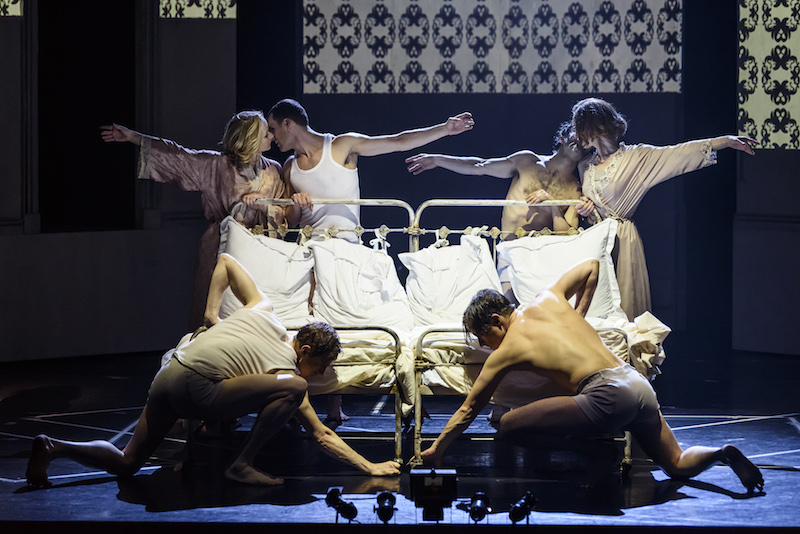 |
| Source - The Arts Desk, Bill Cooper |
This piece confused me.
So I would have been fine if it was meant to be an eclectic pastiche of pretty sights and sounds. But with director cum choreographer Javier de Frutos intimating that each of the 4? 5? Lises and Pauls were supposed to represent different facets of this doomed sibling duo, I kept looking for deeper meaning in the clash of identities, only to constantly come up empty.
It was fairly simple at the beginning, where the different pairings of Lises and Pauls adopted much of the same characterizations, flirting innocently and then dangerously in the bathtub together. All pairs had the same costumes, the same props, the same steps, and I could deal with this nice colouring around the edges of each character, which was quite à la Matthew Bourne's Song Without Words. (de Frutos clearly has a knack for painting a scene with movement, able to deftly control the ebb and flow of motion, and accentuate subtleties in the score.)
But the moment Jennifer Davis and Gyula Nagy come on stage, singing Philip Glass' very literal libretto, they cannot help but strike an extremely different note from the dancers around them. Their threads of the storyline are transparent and pointed in a way that the dancers' motions cannot be, and so they end up drawing much of the attention. Thus as much as the publicity posters and the order of the curtain call try to tell me otherwise, Edward Watson and Zenaida Yanowsky are not the key players of this piece.
In some ways, I can see how they were designed to be so. Though Davis and Nagy are literal and obvious, they are flatter because of it. One can suppose that in contrast, Watson and Yanowsky represent the deeper and more fascinating subconscious of the characters that are both aware of and conflicted about the true danger of their game. Davis and Nagy portray childish petulance from start to finish, but Watson and Yanowsky express delicious love, malice, regret, despair, insanity. However all of this is shunned to the sidelines, obscured behind other performers, or simply done away with too quickly. Even when they are the highlight, their choreography is far too poised and statuesque to be as earthy and real as the characters they supposedly represent. So if they are indeed meant to be the richer body of the piece, this is done quite ineffectively.
Regardless, the question of who carries the meat of the storyline is moot by the end of the piece, because as time goes on each performer acquires such different movement, props, and costumes that keeping track of what the point of it all is becomes a bit hopeless. As such, my fancy flitted to the one stable character of the piece -- that is, Jean Marc Puissant's gorgeous set. It mostly comprises a fairly minimalist set of 5 sliding walls with modular steps, but onto these are projected beautiful displays that range from a whimsical sideways Eiffel tower during Paul's sleep walk, to a trypophobia-inducing collage of eyes during the children's first game. To be fair however, it does brink on over-busyness just like the rest of the piece -- where the performers are constantly shifting set pieces, picking up errant socks, or locking down a shaky wall mid-choreography. It was even the source of a full-on interruption of the performance on premiere night, where one wall piece wouldn't budge and the scene had to be repeated from the beginning.
All in all, maybe the point is to confuse. Or the point is to walk away flooded with a nice mélange of sights and sounds. But I can't help but think that with a story as poignant as Les Enfants Terribles, I should at least feel something by the end of it. And in particular, knowing what the combined dramatic prowess of Watson and Yanowsky might have done in different hands, the most coherent feeling I leave with is sadly one of disappointment.
No comments:
Post a Comment